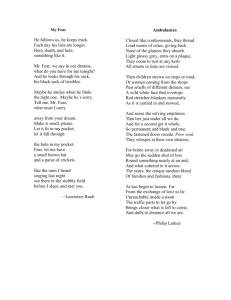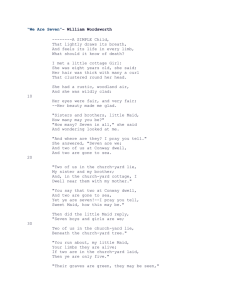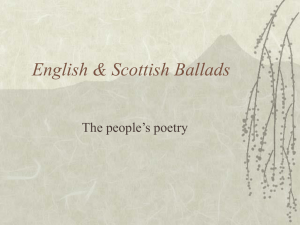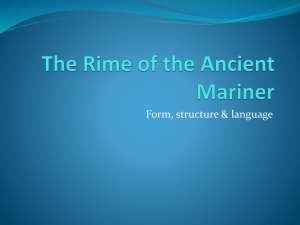We Are Seven
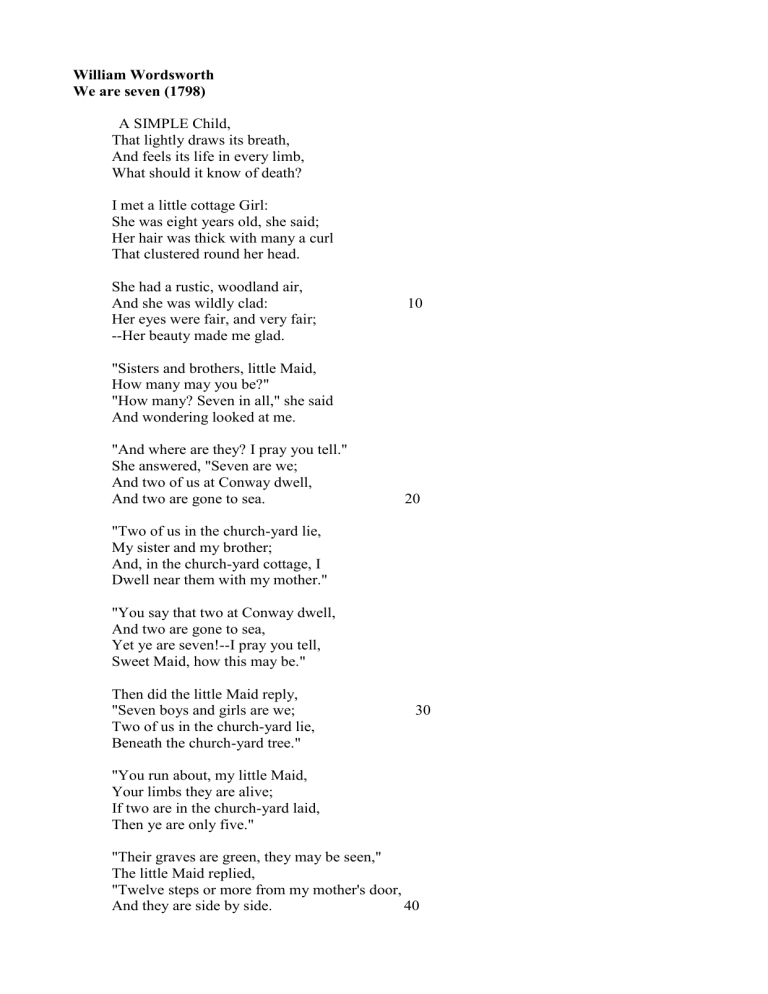
William Wordsworth
We are seven (1798)
A SIMPLE Child,
That lightly draws its breath,
And feels its life in every limb,
What should it know of death?
I met a little cottage Girl:
She was eight years old, she said;
Her hair was thick with many a curl
That clustered round her head.
She had a rustic, woodland air,
And she was wildly clad: 10
Her eyes were fair, and very fair;
--Her beauty made me glad.
"Sisters and brothers, little Maid,
How many may you be?"
"How many? Seven in all," she said
And wondering looked at me.
"And where are they? I pray you tell."
She answered, "Seven are we;
And two of us at Conway dwell,
And two are gone to sea. 20
"Two of us in the church-yard lie,
My sister and my brother;
And, in the church-yard cottage, I
Dwell near them with my mother."
"You say that two at Conway dwell,
And two are gone to sea,
Yet ye are seven!--I pray you tell,
Sweet Maid, how this may be."
Then did the little Maid reply,
"Seven boys and girls are we; 30
Two of us in the church-yard lie,
Beneath the church-yard tree."
"You run about, my little Maid,
Your limbs they are alive;
If two are in the church-yard laid,
Then ye are only five."
"Their graves are green, they may be seen,"
The little Maid replied,
"Twelve steps or more from my mother's door,
And they are side by side. 40
"My stockings there I often knit,
My kerchief there I hem;
And there upon the ground I sit,
And sing a song to them.
"And often after sunset, Sir,
When it is light and fair,
I take my little porringer,
And eat my supper there.
"The first that died was sister Jane;
In bed she moaning lay, 50
Till God released her of her pain;
And then she went away.
"So in the church-yard she was laid;
And, when the grass was dry,
Together round her grave we played,
My brother John and I.
"And when the ground was white with snow,
And I could run and slide,
My brother John was forced to go,
And he lies by her side." 60
"How many are you, then," said I,
"If they two are in heaven?"
Quick was the little Maid's reply,
"O Master! we are seven."
"But they are dead; those two are dead!
Their spirits are in heaven!"
'Twas throwing words away; for still
The little Maid would have her will,
And said, "Nay, we are seven!"
Interpretation Notes for We are Seven by William Wordsworth by Zita Nyikes Year 2 Part time
Background
- written at Alfoxden in the spring of 1798
- the little girl who is the heroine WW met within the area of Goodrich Castle in the year 1793
Characters
- little girl, the little Maid
- Poet and Narrator
Form
- dialogue: ballads often incorporate multiple characters into their stories. Often, since changes of
voice were communicated orally, written transcriptions of oral ballads give little or no indication that the speaker has changed. Writers of literary ballads , the later poems that imitate oral ballads, sometimes play with this convention.
- third-person objective narration: ballad narrators usually do not speak in the first person (unless speaking as a character in the story), and they often do not comment on their reactions to the emotional content of the ballad.
- ballad stanza: traditional ballad stanza consists of four lines, rhymed abcb (or sometimes abab -the key is that the second and fourth lines rhyme). The first and third lines have four stresses, while the second and fourth have three.
Style
- gradual development of dramatic tension
- ballad : a story usually a narrative or poem, in a song. Any story form may be told as a ballad, such as historical accounts or fairy tales in verse form. Some ballads are carefully crafted poems written by literate authors and meant to be read silently such as those in Lyrical Ballads by
Wordsworth and Coleridge. The folk ballad (or popular ballad, or traditional ballad) is derived from the oral tradition.
- simple language: older traditional ballads were composed for audiences, therefore they feature language that people can understand without specialist training or repeated readings. Poets choose to write ballads emphasised on simple language.
- narrative story: the poem tells a story and the emotions of the speaker
- repetition: a ballad often has a refrain , a repeated section that divides segments of the story.
Many ballads also employ incremental repetition, in which a phrase recurs with minor differences as the story progresses
Theme
Death
- Wordsworth demonstrates a child's refusal to acknowledge the dead as being gone
- the persistent questioning about the size of the girl's family proves that the family now consists of five members instead of seven because two siblings are dead. However the girl continually and stubbornly insists that there are seven of them.
Interpretation: 1. the young girl truly cannot comprehend the idea of death
2. she readily accepts death, and her brother and sister merely live on through her memories
- the poem demonstrates a child's difficulty at comprehending the idea of death and embodies a child's blissful view of unity even after death.
My stockings there I often knit
My kerchief there I hem
And there upon the ground I sit
And sing a song to them.
- the girl is not disturbed by the idea of death or after death
So in the church-yard she was laid;
And, when the grass was dry,
Together round her grave we played,
My brother John and I.
And when the ground was white with snow,
And I could run and slide,
My brother John was forced to go,
And he lies by her side.
- the girl refuses to acknowledge the death of her siblings as a complete separation from them; the simply stubborn refusal to accept death has become more of an acceptance or avoidance of death
- the girl does not outright deny death because she talks about burials, graves
- the girl chooses to accept that they are gone physically; they are still with her in spirit, and as long as the girl imagines her brother and sister playing right along with her, her family remains whole.
- the girl's insistence on the family as seven serves psychological purpose of allowing her some control over an uncontrollable circumstance
- on the surface the poem seems puerile, relating a child singing and playing merrily
- the repetition of the most paramount words in the poem, these being, “we are seven” serve not only to emphasize the central theme of a child's inability to handle death, but also demonstrate the complexity of the matter of discussion
- the final reply “Nay, we are seven!” close the poem as the girl's lack of ability to accept death
- the poem begins as a simple everyday conversation and finished as a didactic and somewhat emotional poem
- the poem is deep and meaningful in contrast to Wordsworth's intention, who started the poem as a real life conversation
Sources:
- < http://www.bartleby.com/145/ww1240.html>
- <http://www.123helpme.com/view.asp?id=8350>
- Szerdahelyi, István.
Irodalomelméleti enciklopédia
(Eötvös József Könyvkiadó, Budapest: 1995)
